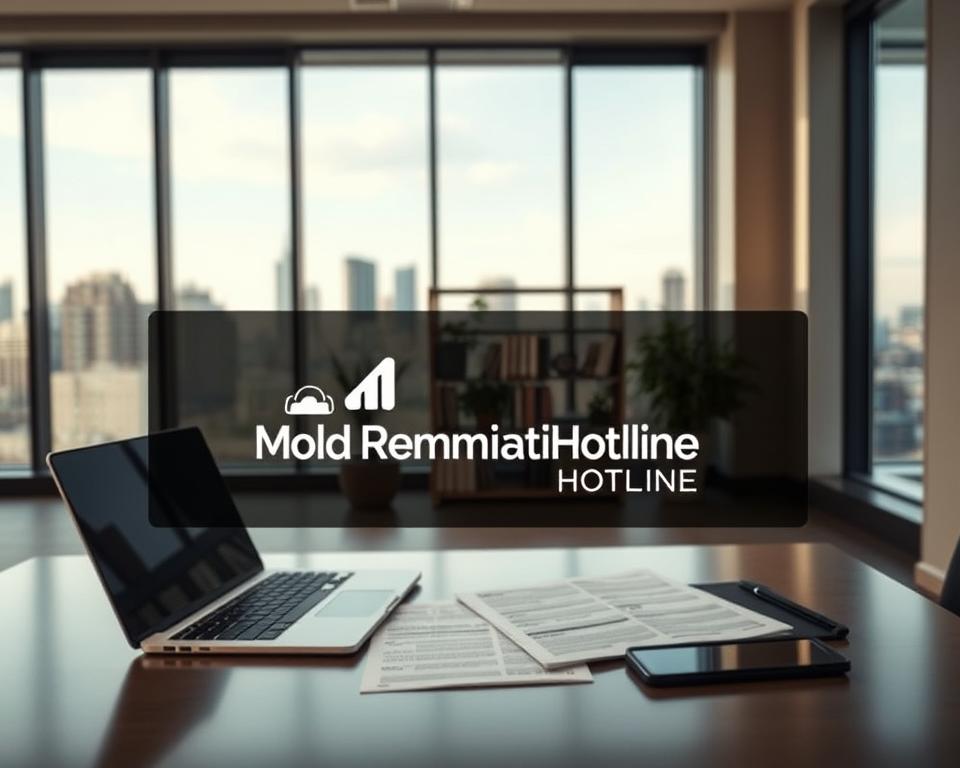Why might two homeowners pay vastly different prices for the same service? This question often arises when dealing with unwelcome biological growth in living spaces. Understanding pricing variations requires examining local market dynamics, property-specific challenges, and service provider expertise.
Industry data reveals that addressing these issues typically ranges from $1,500 to $9,000 nationally. However, regional labor rates and accessibility to affected areas significantly influence final estimates. Properties with extensive contamination or complex layouts often require specialized equipment, increasing project expenses.
Local comparisons prove essential because regulations and environmental factors vary by state. Coastal regions might face higher humidity-related challenges, while older urban buildings could encounter hidden structural complications. Professional assessments remain crucial for accurate budgeting and preventing recurring problems.
Key Takeaways
- Service pricing varies by location due to labor rates and environmental factors
- Structural complexity impacts equipment needs and overall project scope
- Professional evaluations help identify hidden risks and prevent future outbreaks
- Preventative measures reduce long-term maintenance expenses
- Local service providers understand regional building codes and climate challenges
Understanding Mold Remediation and Its Importance
Biological infestations in homes demand specialized attention to ensure long-term safety. Proper management involves eliminating visible growth while addressing moisture sources that fuel its spread. This systematic approach prevents recurring issues and protects indoor air quality.
What Does the Removal Process Involve?
Effective biological growth management follows a structured protocol. Specialists first identify contamination levels through detailed inspections. They then isolate affected areas using physical barriers and negative air pressure. Advanced cleaning methods remove colonies while specialized equipment filters microscopic particles from the air.
Why Expertise Makes a Difference
Untrained removal attempts often spread spores to new areas, creating larger problems. Certified technicians understand how to safely eliminate hidden growth behind walls or under flooring. Their methods prevent cross-contamination and address root causes like leaks or poor ventilation.
Inadequate treatment leaves behind allergens that cause health problems, particularly for those with asthma or weakened immune systems. Professional services ensure complete eradication while meeting local safety standards. This reduces long-term risks and protects property value.
Signs and Health Implications of Mold Exposure
Unseen threats in homes often manifest through physical reactions and visible clues. Early detection helps prevent long-term complications and protects household air quality.
Recognizing Household Contamination
Distinct odors and surface changes often signal biological growth. Musty smells resembling damp soil frequently appear before visible signs. Warped drywall, peeling paint, or discolored grout lines indicate moisture issues that fuel spore development.
Approximately 28% of allergy sufferers react to airborne particles from fungal colonies. Common allergy symptoms include persistent sneezing, itchy eyes, and throat irritation. These reactions often worsen in specific rooms or during humidity spikes.
| Visual Clues | Odor Indicators | Health Effects |
|---|---|---|
| Black/green speckles | Earthy dampness | Sinus congestion |
| Bubbling wallpaper | Rotting wood scent | Skin rashes |
| White fuzzy patches | Stale laundry smell | Respiratory distress |
Individuals with compromised immune systems face heightened risks. Fungal spores can cause health problems like bronchitis or exacerbate asthma. The CDC reports 4.6 million annual asthma cases linked to indoor air quality issues.
Even minor infestations require attention. Spores multiply rapidly, increasing exposure risks. Those with compromised immune systems should prioritize professional assessments when experiencing prolonged allergy symptoms without clear triggers.
Factors Affecting Mold Remediation Costs
Homeowners often underestimate the variables influencing fungal removal expenses. Four primary elements determine project cost: contamination scale, biological growth type, regional pricing, and structural repairs needed.
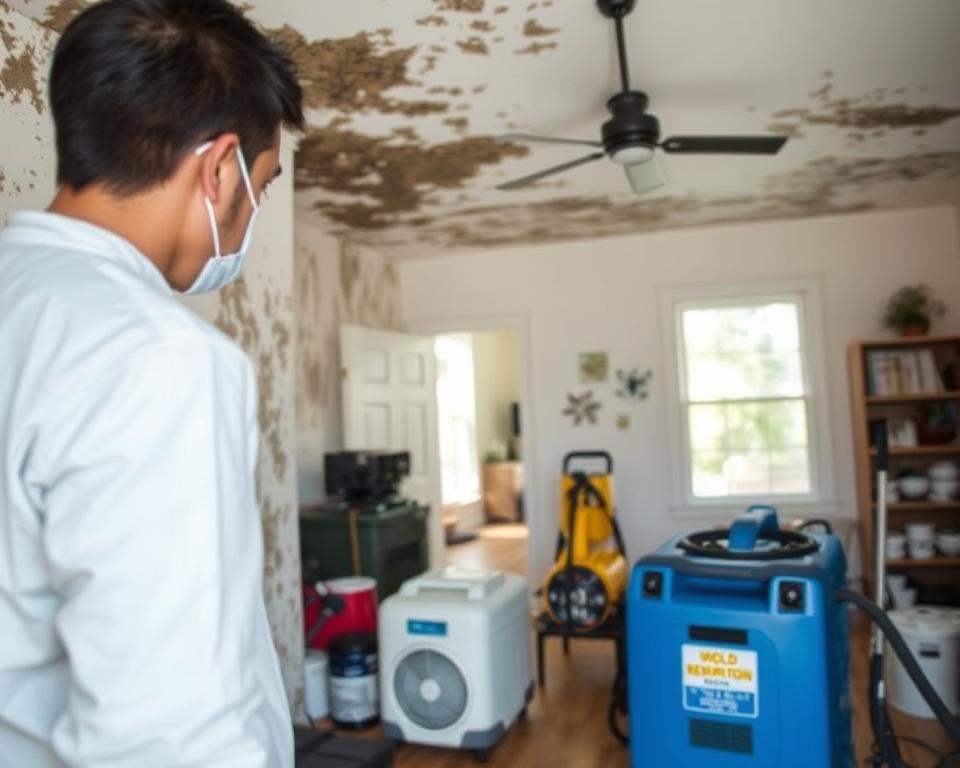
Contaminated area size creates the most dramatic price swings. A 10-square-foot patch might cost $500-$1,000, while whole-house treatments can exceed $30,000. Larger spaces require more labor hours and specialized equipment like HEPA vacuums.
Dangerous growth varieties demand pricier protocols. Black fungal colonies need full containment systems, increasing average cost by 25-40% compared to common mildew removal.
| Factor | Impact Level | Cost Range |
|---|---|---|
| Small Area (Under 10 sq ft) | Low | $500 – $1,500 |
| Structural Damage | High | $2,000 – $7,000+ |
| Toxic Varieties | Critical | $3,000 – $10,000 |
Labor accounts for 60% of remediation costs nationwide. Certified technicians charge $30-$120 hourly depending on regional rates. Material expenses like antimicrobial sprays and drywall replacements make up the remaining 40%.
Industry reports show coastal states pay 18% more due to humidity challenges. Always request itemized quotes to understand what drives your specific estimate.
Mold Remediation Cost by Location
Different areas of a house present unique challenges that influence cleanup costs. Structural features and accessibility determine labor time, equipment needs, and material expenses. Addressing growth in confined spaces often requires specialized techniques compared to open, ventilated rooms.
Attics, Basements, and Crawl Spaces
Tight spaces like crawl spaces increase project difficulty. Technicians may charge $1,200-$4,500 for these areas due to limited movement and protective gear requirements. Basements with poor ventilation often need air scrubbers, adding $500-$1,200 to total costs.
Bathrooms and Kitchens
Visible growth on non-porous surfaces typically costs $300-$1,800. These rooms allow easier access to plumbing leaks – the root cause in 67% of cases. Standard house mold remediation here focuses on sealing moisture sources after surface cleaning.
HVAC Systems and Whole-House Remediation
Contaminated air ducts spread spores rapidly, requiring full hvac system cleaning ($3,000-$10,000). Whole-home treatments average $6,000-$20,000 due to cross-contamination risks. Projects involving structural repairs or content relocation see costs rise by 30-50%.
Labor rates vary by region, but location-specific challenges consistently impact budgets. Always verify if quotes include post-cleanup air quality tests – a critical step often overlooked in house mold remediation projects.
Cost per Square Foot: Area Considerations
How does the size of contaminated spaces impact your budget? Service providers typically calculate expenses using per square foot measurements. This approach accounts for materials, labor hours, and equipment needed to address biological growth effectively.
Standard pricing ranges from $10 to $30 per square, with variations based on project complexity. A 100-square-foot bathroom might cost $1,000-$3,000, while a 500-square-foot basement could reach $5,000-$15,000. Larger areas often require more containment barriers and air filtration systems.
| Square Footage | Cost per Square Foot | Total Estimate Range |
|---|---|---|
| 50-100 | $10-$18 | $500-$1,800 |
| 100-300 | $15-$25 | $1,500-$7,500 |
| 300+ | $20-$30 | $6,000-$9,000+ |
Hidden colonies behind walls or under flooring increase labor time. Technicians might charge 15-20% more for these challenging spaces. Smaller visible patches prove more affordable but still require thorough moisture control measures.
Always request detailed measurements in quotes. Some companies offer tiered pricing – lower per square foot rates for larger projects. This structure balances intensive labor needs with material costs across different space sizes.
Mold Remediation Cost for Different Mold Types
Not all fungal growths demand equal treatment—some species require military-grade protocols. Removal expenses swing dramatically based on biological risks and structural threats. Specialized handling becomes essential for aggressive varieties that compromise air quality or building integrity.
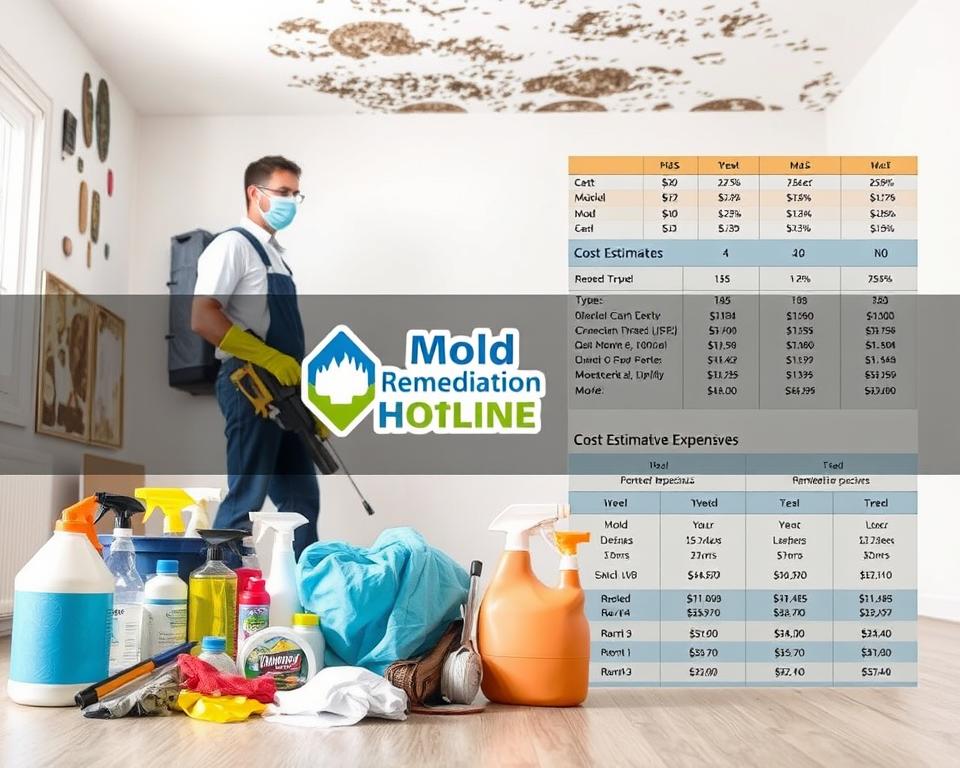
Serpula lacrymans, often called “house-eating mold,” destroys wooden structures rapidly. Eradicating this dry rot fungus costs $3,500-$15,000 due to:
- Mandatory structural reinforcements
- Full containment chambers
- Post-treatment wood preservatives
White fuzzy growths might seem harmless but spread through ventilation systems silently. Though less toxic than black variants, white mold removal still averages $1,800-$5,200. Technicians focus on:
- Air duct sanitization
- Humidity control systems
- Preventative sealants
| Mold Type | Risk Level | Cost Range |
|---|---|---|
| Black (Stachybotrys) | High | $2,500-$10,000 |
| Serpula lacrymans | Critical | $3,500-$15,000 |
| White (Aspergillus) | Moderate | $1,800-$5,200 |
High-risk species demand OSHA-approved respirators and negative air pressure systems. These safety measures add $400-$1,200 to projects. Always verify technicians test growth samples—proper identification prevents budget surprises.
Detailed Breakdown of the Professional Remediation Process
Specialized teams follow a rigorous seven-stage protocol to ensure complete spore elimination. The mold remediation process begins with digital moisture mapping and air quality testing. Technicians then seal off affected zones using plastic sheeting to prevent cross-contamination.
Surface cleaning involves scrubbing with EPA-approved antimicrobial solutions. Air scrubbers with HEPA filters run continuously during this phase, capturing 99.97% of airborne particles. These devices typically process 300-1,500 cubic feet per minute, depending on space size.
Damaged drywall or insulation requires careful removal using negative-pressure vacuums. Labor accounts for 60% of project expenses during this phase, while materials like replacement boards make up 40%. Workers bag contaminated debris in sealed containers for hazardous waste disposal.
The final restoration phase includes applying protective sealants and reconstructing surfaces. Post-treatment air tests verify spore levels meet safety standards. Proper execution of each step prevents regrowth and protects indoor environments from hidden threats.
DIY vs. Professional Mold Removal Methods
When should homeowners tackle biological growth themselves versus calling experts? Surface-level issues on non-porous materials like tile or glass often permit cautious DIY efforts. These small-scale projects typically involve scrubbing with detergent solutions and proper ventilation.
- Visible patches under 10 square feet
- Non-porous surfaces like shower walls
- Areas without HVAC system connections
| Approach | Safety | Effectiveness | Cost Range |
|---|---|---|---|
| DIY | Moderate risk without PPE | Limited to surface cleaning | $50-$300 |
| Professional | Containment protocols | Full eradication | $1,500-$9,000 |
Hidden colonies behind drywall or under flooring demand professional intervention. Improper remove mold attempts often spread spores, increasing health risks and future expenses. Structural repairs after botched DIY jobs can triple initial savings.
Health concerns like asthma or immune disorders require expert handling. Certified teams use industrial-grade air scrubbers and moisture meters to address root causes. Their methods prevent regrowth while meeting local safety codes.
While cost mold removal services appear expensive upfront, they often prove economical long-term. Professionals eliminate hidden threats that DIY kits miss, reducing repeat treatments. Always prioritize safety over short-term savings for airborne contamination cases.
The Impact of Labor and Materials on Overall Costs
Labor and material expenses form the backbone of fungal removal budgets. Industry reports confirm 60% of project funds cover skilled technicians, while 40% addresses supplies. This split reflects the specialized training and safety protocols required for effective biological growth management.
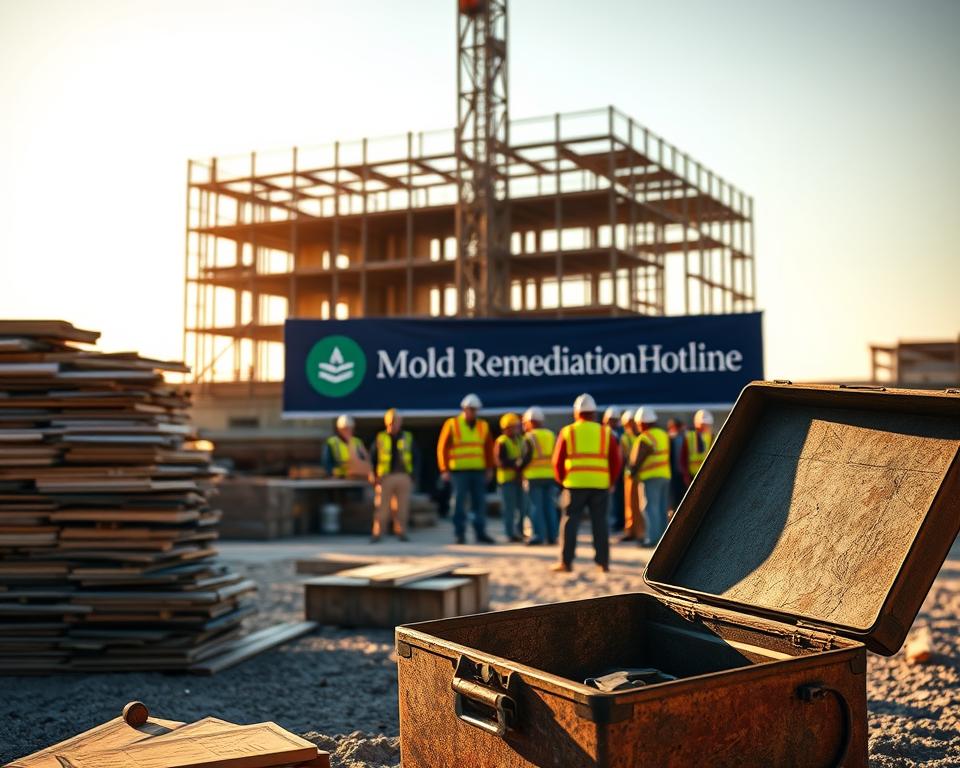
Certified teams command higher wages due to hazardous material handling certifications. A single technician typically charges $45-$95 hourly, with complex jobs requiring 3-5 workers. Time-intensive tasks like air duct cleaning or structural repairs amplify these expenses significantly.
Material costs include:
- Antimicrobial sprays ($20-$50 per gallon)
- HEPA air scrubbers ($200-$800 daily rentals)
- Replacement drywall ($12-$20 per sheet)
| Expense Category | Average Percentage | Key Components |
|---|---|---|
| Labor | 60% | Wages, insurance, equipment operation |
| Materials | 40% | Cleaning agents, containment barriers, rebuilding supplies |
Projects spanning multiple rooms often see costs per square foot decrease by 12-18% due to bulk material pricing. However, jobs requiring asbestos testing or historical building preservation can double baseline estimates. Always review itemized quotes to distinguish essential services from optional upgrades.
Understanding these financial drivers helps homeowners evaluate service providers effectively. Transparent breakdowns prevent unexpected charges and ensure funds address critical contamination issues first.
The Importance of Mold Inspection and Testing
Accurate identification of household contaminants requires more than a visual check. Professional evaluations detect hidden colonies and moisture sources that fuel growth. Without proper assessment, treatment efforts often miss root causes, leading to recurring issues.
Certified inspectors follow EPA guidelines, using infrared cameras and moisture meters. They collect air samples to identify fungal types and measure spore concentrations. Lab analysis determines whether a mold remediation company must handle containment protocols.
Water damage assessments form a critical inspection component. Technicians trace plumbing leaks and measure wall humidity levels. These findings create targeted drying plans before cleanup begins, preventing future outbreaks.
Inspection fees range from $50 to $700 based on home size and testing methods. Comprehensive packages include:
- Detailed moisture mapping
- Species identification reports
- Remediation priority charts
The CDC prioritizes health risk evaluations, while EPA standards focus on moisture source elimination. Both agencies stress professional assessments to avoid incomplete treatments. Proper inspections map containment zones and safe worker pathways, reducing cross-contamination risks during removal.
Compare Mold Remediation Costs Near Me
Regional pricing variations for biological contaminant removal often surprise property owners. Local market conditions create significant differences in service charges, even for identical square footage. Coastal cities like Miami show 22% higher averages than arid regions such as Phoenix due to humidity challenges.
Urban centers with older infrastructure typically incur greater expenses. Chicago’s historic districts report fungal cleanup costs 18% above newer suburbs. These differences stem from:
- Varying permit requirements
- Local disposal regulations
- Building material availability
| Region | Average Price | Key Factors |
|---|---|---|
| South Florida | $2,800-$6,500 | High humidity, strict containment rules |
| Southwest Desert | $1,900-$4,200 | Dry climate reduces spore spread |
| Midwest Metro | $2,300-$5,800 | Aging plumbing systems |
Neighborhood-specific data reveals further disparities. ZIP code 33139 (Miami Beach) shows prices 15% higher than mainland areas due to saltwater corrosion risks. Always verify service providers understand regional building codes and microclimate challenges.
Obtaining three localized quotes remains crucial for fair pricing. Reputable companies provide breakdowns showing labor rates, material costs, and containment needs. This transparency helps homeowners avoid overpaying while ensuring thorough spore eradication.
Tips for Hiring a Mold Remediation Company
Selecting the right team for household contamination issues requires careful vetting and industry knowledge. A qualified remediation company combines technical expertise with transparent communication, ensuring both safety and value.
Essential Questions to Ask Contractors
Start by verifying their approach to containment and air quality control. Ask:
- “What certifications does your team hold?”
- “Does your insurance cover secondary contamination?”
- “Can you provide references from similar projects?”
Reputable firms follow IICRC S520 standards for structural drying and spore removal. They should explain moisture source identification methods and post-cleanup verification processes.
Certifications and Insurance Considerations
Valid credentials prove technical competency. Look for:
- IICRC Microbial Remediation Specialist certification
- State-specific contractor licenses
- Pollution liability coverage exceeding $1 million
As one industry expert notes:
“Proper insurance protects homeowners from unexpected costs if spores spread during treatment.”
Obtain three detailed quotes to compare cost mold remediation estimates. Prioritize companies offering independent post-remediation inspections – this ensures accountability. Firms with advanced moisture detection tools often deliver more accurate pricing and lasting results.
Cost-Saving Strategies in Mold Remediation
Smart budgeting for home contamination issues starts with strategic prevention and informed decisions. Addressing water damage within 48 hours reduces cleanup expenses by up to 40%, according to restoration industry studies. Quick action prevents spores from colonizing porous materials like drywall or insulation.
Obtaining three detailed quotes helps identify fair pricing structures. Many providers offer free assessments, allowing homeowners to compare containment methods and material quality. Negotiate bundled services when dealing with both water damage and existing growth.
Post-cleanup cosmetic adjustments create additional savings. Opt for paintable sealants instead of full wall replacements in low-visibility areas. Simple ventilation upgrades like installing bathroom fans prevent humidity buildup, reducing long-term cost mold recurrence risks.
Preventative maintenance slashes future expenses dramatically. Annual gutter cleaning and foundation inspections catch moisture issues early. Data shows homes with dehumidifiers in damp zones experience 67% fewer fungal outbreaks.
Combine these approaches for maximum financial protection. As one contractor notes:
“Investing $200 in pipe insulation often prevents $5,000 remediation projects.”
Strategic planning transforms reactive spending into controlled, predictable homecare budgets.
Preventative Measures to Avoid Future Mold Growth
Proactive home care creates the first defense against unwelcome biological issues. Regular maintenance and moisture control form a critical barrier against fungal development. Simple adjustments to daily habits significantly reduce dampness and protect indoor environments.
Essential Humidity Management Tactics
High humidity levels above 60% create ideal conditions for spore activation. Use digital hygrometers to monitor moisture in basements and bathrooms. Dehumidifiers remove 30-50 pints of water daily from air in problem areas.
Proper ventilation reduces condensation risks. Install exhaust fans in kitchens and laundry rooms, running them 20 minutes post-use. Open windows during dry weather to circulate fresh air through storage spaces.
| Prevention Method | Effectiveness | Frequency |
|---|---|---|
| Dehumidifier use | Reduces moisture by 40% | Daily in damp seasons |
| Gutter cleaning | Prevents roof leaks | Twice yearly |
| Pipe insulation | Avoids condensation | During home upgrades |
Seal cracks in foundations and around windows with waterproof caulk. Inspect plumbing fixtures quarterly – a single drip wastes 90 gallons monthly. Address leaks within 48 hours to prevent hidden moisture buildup.
Industry studies show homes with routine maintenance experience 73% fewer fungal outbreaks. As one environmental specialist notes:
“Consistent moisture control proves more affordable than emergency remediation services.”
Additional Considerations for High Humidity and Water Damage
Environmental factors dramatically influence biological growth risks in residential spaces. Humidity levels above 60% create ideal conditions for spore activation, particularly in poorly ventilated air ducts and wall cavities. Unresolved leaks from appliances or plumbing accelerate contamination spread through hidden structural layers.
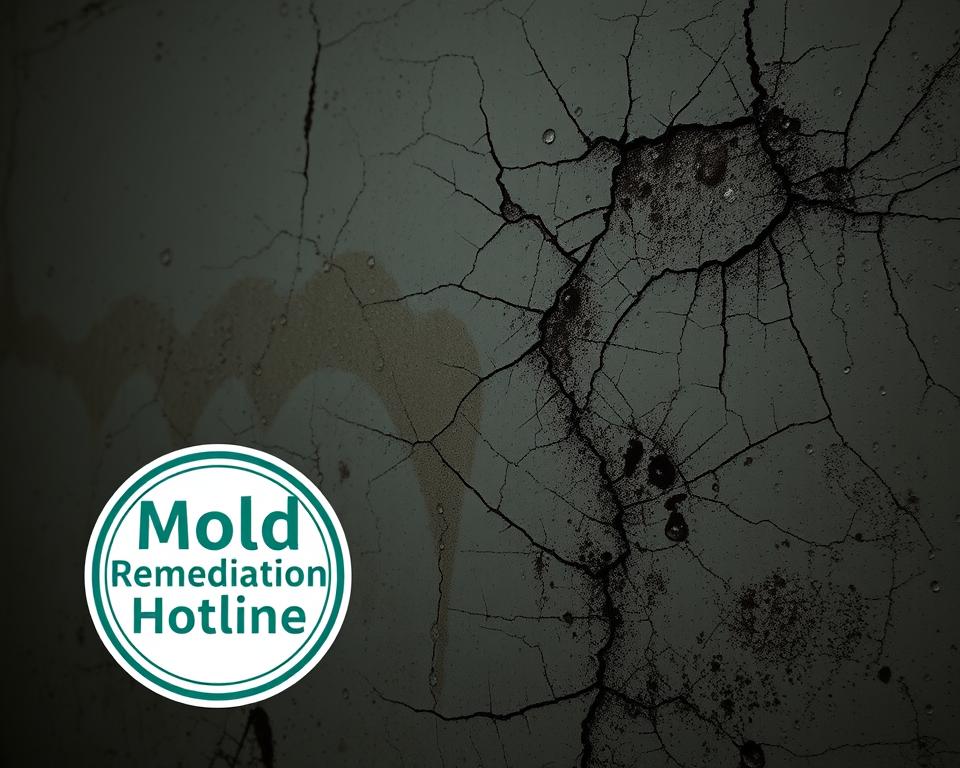
Chronic water damage triples remediation expenses by promoting deep colonization in porous materials. Insurance claims data shows delayed leak repairs increase average cleanup costs from $1,200 to $4,800. Attics and crawl spaces often harbor unseen issues due to condensation buildup and limited airflow.
| Timeframe | Average Repair Cost | Potential Consequences |
|---|---|---|
| 48 Hours | $400-$1,100 | Surface drying prevents colonization |
| 1 Week | $1,800-$5,200 | Subfloor replacement needed |
| 1 Month+ | $4,500-$12,000 | Structural weakening occurs |
Professionals use thermal imaging to detect moisture in areas prone to fungal issues like behind baseboards or under sinks. Their assessments identify at-risk zones before visible signs appear. Regular HVAC inspections prevent spore circulation through ventilation systems.
Effective mitigation combines:
- Dehumidifiers maintaining 30-50% humidity
- Pipe insulation to prevent condensation
- Immediate leak containment protocols
As one restoration expert notes:
“Addressing humidity control cuts repeat service calls by 65% in coastal regions.”
Conclusion
Maintaining a healthy home environment requires addressing biological contaminants promptly and effectively. This guide has explored how project scope, regional factors, and professional expertise influence outcomes. Certified technicians bring critical knowledge to safely remove mold while preventing cross-contamination.
Ignoring early signs risks severe allergy symptoms and structural damage. Rapid response limits spore spread and reduces long-term expenses. Proper mold removal methods eliminate hidden colonies that DIY efforts often miss.
Homeowners should prioritize licensed specialists who follow EPA guidelines. These professionals identify moisture sources and ensure air quality meets safety standards. Their work protects vulnerable individuals from respiratory issues linked to poor indoor environments.
If you suspect contamination, act immediately. Delayed treatment allows growth to penetrate walls and HVAC systems. Schedule an inspection today to safeguard your property and family health.
FAQ
How does mold type influence remediation expenses?
Can compromised immune systems affect remediation urgency?
Why do HVAC systems raise overall project costs?
Does homeowners insurance cover water damage-related mold?
How do air quality tests impact remediation budgets?
Are crawl space treatments cost-effective long-term?
FAQ
How does mold type influence remediation expenses?
Certain species, like toxic black mold or Serpula lacrymans (dry rot), require specialized containment and cleaning methods, increasing labor and material costs. Non-toxic varieties, such as white mold, often have lower removal fees.
Can compromised immune systems affect remediation urgency?
Yes. Individuals with respiratory issues or weakened immunity face higher risks from airborne spores. Professionals use air scrubbers and containment barriers to prevent cross-contamination during the process.
Why do HVAC systems raise overall project costs?
Ductwork cleaning demands specialized equipment to eliminate spores and prevent recirculation. Contaminated systems may also require filter upgrades or antimicrobial treatments to stop regrowth.
Does homeowners insurance cover water damage-related mold?
Coverage varies. Most policies exclude long-term humidity issues but may pay for sudden leaks (e.g., burst pipes). Always review your policy and document damage with timestamped photos.
How do air quality tests impact remediation budgets?
Pre- and post-testing by certified inspectors adds 0–0 but provides verification of spore reduction. This step is critical for real estate transactions or health-related disputes.
Are crawl space treatments cost-effective long-term?
Encapsulation and vapor barriers prevent moisture intrusion, reducing recurring cleanup needs. While upfront costs range from
FAQ
How does mold type influence remediation expenses?
Certain species, like toxic black mold or Serpula lacrymans (dry rot), require specialized containment and cleaning methods, increasing labor and material costs. Non-toxic varieties, such as white mold, often have lower removal fees.
Can compromised immune systems affect remediation urgency?
Yes. Individuals with respiratory issues or weakened immunity face higher risks from airborne spores. Professionals use air scrubbers and containment barriers to prevent cross-contamination during the process.
Why do HVAC systems raise overall project costs?
Ductwork cleaning demands specialized equipment to eliminate spores and prevent recirculation. Contaminated systems may also require filter upgrades or antimicrobial treatments to stop regrowth.
Does homeowners insurance cover water damage-related mold?
Coverage varies. Most policies exclude long-term humidity issues but may pay for sudden leaks (e.g., burst pipes). Always review your policy and document damage with timestamped photos.
How do air quality tests impact remediation budgets?
Pre- and post-testing by certified inspectors adds $300–$600 but provides verification of spore reduction. This step is critical for real estate transactions or health-related disputes.
Are crawl space treatments cost-effective long-term?
Encapsulation and vapor barriers prevent moisture intrusion, reducing recurring cleanup needs. While upfront costs range from $1,500–$4,000, they often lower humidity-related repairs over time.
What certifications should a reliable contractor hold?
Look for IICRC (Institute of Inspection Cleaning and Restoration Certification) or ACAC (American Council for Accredited Certification) credentials. These ensure adherence to EPA guidelines and industry safety standards.
Can improper DIY methods cause hidden structural damage?
Yes. Bleach-based cleaners or incomplete drying often worsen wood rot and drywall degradation. Professionals use moisture meters and thermal imaging to locate hidden issues early.
,500–,000, they often lower humidity-related repairs over time.
What certifications should a reliable contractor hold?
Look for IICRC (Institute of Inspection Cleaning and Restoration Certification) or ACAC (American Council for Accredited Certification) credentials. These ensure adherence to EPA guidelines and industry safety standards.
Can improper DIY methods cause hidden structural damage?
Yes. Bleach-based cleaners or incomplete drying often worsen wood rot and drywall degradation. Professionals use moisture meters and thermal imaging to locate hidden issues early.
